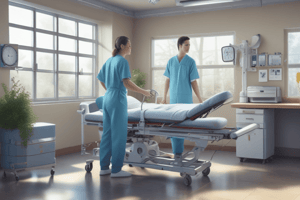Podcast
Questions and Answers
What is the primary benefit of using proper body mechanics?
What is the primary benefit of using proper body mechanics?
- Faster movement speed
- Enhanced flexibility
- Reduced risk of musculoskeletal injury (correct)
- Increased energy levels
Which position involves the patient lying face up?
Which position involves the patient lying face up?
- Knee-chest position
- Dorsal recumbent position (correct)
- Fowler position
- Prone position
What is the purpose of creating a wide base of support?
What is the purpose of creating a wide base of support?
- To lower the body's center of gravity (correct)
- To maintain breathing ease
- To allow for quick movements
- To facilitate stretching
Which position should the patient's head be in during the Trendelenburg position?
Which position should the patient's head be in during the Trendelenburg position?
What is meant by maintaining proper body alignment?
What is meant by maintaining proper body alignment?
In which position is the patient seated at an angle of 45-60 degrees?
In which position is the patient seated at an angle of 45-60 degrees?
The reverse Trendelenburg position involves placing the patient at a 30-degree angle with the head higher than what?
The reverse Trendelenburg position involves placing the patient at a 30-degree angle with the head higher than what?
Which body movement should be avoided to maintain proper body mechanics?
Which body movement should be avoided to maintain proper body mechanics?
Flashcards
Benefit of body mechanics?
Benefit of body mechanics?
Reduces the likelihood of injuries to muscles and skeleton.
Dorsal recumbent position?
Dorsal recumbent position?
Patient lies on their back with knees bent.
Purpose of a wide base?
Purpose of a wide base?
Enhances stability by lowering the center of gravity.
Trendelenburg position?
Trendelenburg position?
Signup and view all the flashcards
Proper body alignment?
Proper body alignment?
Signup and view all the flashcards
High Fowler position?
High Fowler position?
Signup and view all the flashcards
Reverse Trendelenburg?
Reverse Trendelenburg?
Signup and view all the flashcards
Avoid what movement?
Avoid what movement?
Signup and view all the flashcards
Study Notes
Body Mechanics and Mobility
- Body mechanics involve using proper physical coordination of bones, joints, muscles, and the brain during movement.
- Correct body mechanics help healthcare providers avoid musculoskeletal injuries and fatigue while reducing the risk of patient injury.
Principles of Body Mechanics
- A low center of gravity can be maintained by flexing hips and knees rather than bending at the waist, promoting balance and even weight distribution.
- A wide base of support is created by spreading the feet apart, providing lateral stability and lowering the center of gravity.
- Proper body alignment is crucial; keeping the center of gravity over the base of support is essential, and this is achieved by moving feet instead of twisting and bending at the waist.
Patient Positions
- Erect Position: Patient is upright with their back against the receptor; chin raised to avoid being in the image field.
- Supine Position: Patient lies horizontally with the face upward.
- Dorsal Recumbent Position: Patient lies on their back with lower extremities moderately flexed and rotated outward.
- Fowler Position: Patient is seated in a semi-sitting position at 45–60 degrees, often categorized as high Fowler, Fowler, or low Fowler based on the angle of elevation.
- Lateral Position: Patient lies on their left or right side.
- Prone Position: Patient lies face down.
- Sims Position: A variation of the lateral position, often used for certain medical procedures.
- Knee-Chest Position: Patient brings knees to the chest, enhancing access to the rectal area.
- Trendelenburg Position: Patient’s feet and legs are elevated above heart level while lying supine, often used in emergencies.
- Reverse Trendelenburg Position: Patient lies supine at a 30-degree incline, with the head elevated above the pelvis and legs lower than the hips.
Studying That Suits You
Use AI to generate personalized quizzes and flashcards to suit your learning preferences.
Related Documents
Description
Understand the principles of body mechanics to prevent musculoskeletal injuries and fatigue in healthcare providers while reducing patient injury risk. Learn about maintaining a low center of gravity and wide base of support.




